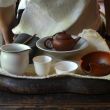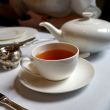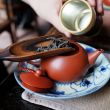Below is an incomplete, but fairly thorough list of common tea terminology. Because remember when you didn't know a latte from an affogato, or a Frappuccino from your Italian uncle? Coffee's had it's turn in the spotlight, and if you trust Oprah's judgement on any and everything (which you do), the time of tea is upon us.
Afternoon Tea: A beloved afternoon ritual that consists of tea, savories (often finger sandwiches) and little sweets. Not to be confused with “high tea,” which is an early evening supper combining dinner and tea. Afternoon tea is also referred to as “low tea,” named after that low energy feeling you get in the afternoon, and which is why you need to break for afternoon tea.
Black Tea: Completely oxidized tea leaves. Interesting tidbit: what we call “black tea” is referred to as “red tea” in China (because of the color of the tea liquor). Popular black teas include Darjeeling and Assam.
Camellia Sinensis: The tea plant. If it didn’t come from Camellia sinensis, it's not considered tea. The only difference between Black, Green, Oolong, Pu’erh, and White teas is in the harvesting and processing method.
Caffeine: The type of caffeine in tea and coffee are the same but tea also has antioxidants and L-theanine which is an amino acid that releases caffeine more slowly (so none of the shakes or jitteriness that you might get from coffee).
Chawan: Translates to “tea bowl,” and is used in the context of preparing matcha. Unlike a regular tea cup, a chawan is a larger bowl with flat bottom which allows you to whisk matcha more easily.
Chanoyu: The Japanese tea ceremony that involves the formal preparation of matcha. Chanoyu is also referred to as the “Way of Tea.”
Cold Brew: Very important for the summer season. This is when you simply place the tea leaves (Japanese sencha is particularly excellent for cold brewing) in a teapot and cover with ice. Let the tea leaves steep in the melting ice, strain, and drink up. Because cold brewing is so gentle, you get all the sweet and grassy notes from the tea with none of the bitterness.
Dust/Dustings: Avoid this. This is what comes in low-quality tea bags. It is the leftovers, literally the “dust” from the tea leaves after the whole leaves have been picked and set aside.
Flavored/Blended Tea: Any tea with additional flavoring from oils, spices, flowers, etc. The most common way to make Earl Grey is by blending black tea with bergamot essential oil. Jasmine is also another popular one, made from green tea scented with jasmine flowers.
Gaiwan: A Chinese tea vessel consisting of a saucer, bowl, and lid. You can drink directly out of a gaiwan (using the lid to hold back the tea leaves), or pour the brewed tea out into smaller cups.
Gong Fu Cha: Translates to “making tea with effort,” and is also known as the traditional Chinese tea ceremony.
Grandpa-Style: No tea strainer in sight? Drink it grandpa-style, using your teeth as the strainer.
Green Tea: Unoxidized tea. Once the tea leaves are picked, they are then steamed or pan-fried, rolled, and dried. Popular green teas include Gunpowder and Gyokuro.
Matcha: Powdered green tea. The entire tea leaf is ground to a fine powder, which you then whisk with hot water and drink. A most amazing concoction. More on matcha here.
Oolong Tea: Semi-oxidized tea. Oxidation levels can range from 20%-70%. The higher the oxidation, the stronger the flavor. The best oolongs come from Taiwan and China. Popular oolongs include Tieguanyin, Dong Ding, and Jin Xuan/Milk Oolong (which has a naturally sweet, milky flavor...definitely worth seeking out).
Organic: Organic is great, yes. But some of the best teas in the world come from small family farms that might operate as organic but don’t have the income (or desire) to participate in the whole organic labeling movement—it costs a literal fortune to secure the “organic” label from the government. More important than sourcing out organic tea just for the sake of the organic label is to buy from tea farms with safe and ethical farming methods.
Pu’erh Tea: One of the five types of tea, and the only type that gets better with age, much like a fine wine. While other teas are sold loose, pu’erh is often sold as compressed cakes or bricks. The most common flavor profile with pu’erh is dark and earthy, some like to refer to pu'erh as manly. Think cigars and steakhouses!
Rooibos: An herbal tisane that comes from a bush plant in South Africa. Red rooibos is more common, but there's also green rooibos (made from the same plant, but skips the oxidation step during processing). Green rooibos is slightly milder in flavor, and both types are naturally caffeine-free.
Tea Bags/Sachets: Loose leaf is ideal but not always possible. When drinking tea brewed from tea bags, stick with larger pyramid sachets which allow the tea leaves to open up fully for maximum flavor extraction. Avoid the shady tea bags filled with dustings (see above) instead of whole leaves.
Tisane: Put all your herbal infusions (which are not technically tea) into this category. Mint, chamomile, chrysanthemum, lemon-verbena, and the list goes on.
Two Leaves and a Bud: Not just the name of a tea company, but a useful tea term. The best teas are literally picked from the tea plant as two leaves with a bud in the center.
White Tea: The least processed of all the tea types, and named after the tiny silver-white hairs that cover the bud of the tea plant. Popular white teas include Bai Hao Yin Zhen/Silver Needle and Bai Mudan. White teas brew up an especially beautiful champagne color and is believe to have higher antioxidant levels than other types of tea.
Yunomi: Japanese term for tea cup. Unlike a chawan (which is used for matcha), yunomi is used for all other Japanese teas (Shincha, Sencha, Hojicha, etc).
—Kathy YL Chan
Photos by Kathy YL Chan, a tea authority based in NYC and Honolulu. She sources tea for private clients and consults for luxury brands on menus and retail tea lines. Follow her on Instagram and Twitter @kathyylchan.






